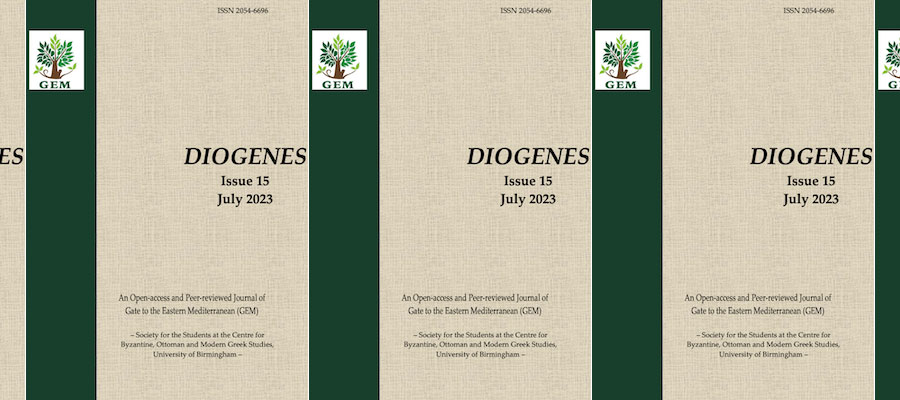Diogenes, issue 15 (July 2023). [Open Access]
CONTENTS INCLUDE
Importing a Past: Alexander, Constantine, and The Serpent Column
Madison Gilmore-Duffey
Originally constructed in the fifth century BCE as a sacrificial tripod to Apollo at Delphi, the Serpent Column was moved by Constantine in the fourth century CE to the Hippodrome in Constantinople. Previous scholarship on the column has emphasized its role as a victory monument and Constantine’s interest in Delphi. Rather than argue against either of these interpretations, I suggest that the column also allowed Constantine to visually link himself to a specific lineage of rulership that expressed a continuity of power and divine favor dating back to Alexander the Great. To do this, I consider the historical events and cultural significance surrounding the Serpent Column, Delphi, and the Cult of Apollo in relation to Constantine and Alexander.
The 4th Tusculan fragment and the anti-Nestorian polemic
Roberta Rosselli
This paper offers some considerations relating to a short passage of one of the so-called Tusculan fragments (Crypt. gr. 54; 6th-7th century AD) in comparison to the main Malalian textual tradition (Baroccianus gr. 182 = Ba). The fragments, indeed, are usually interpreted as an ancient source of Malalas’ Chronography. Without delving into the debatable authorial aspect, we consider the text in relation to contextual and semantic peculiarities, also considering the relation with later sources.
The fourth Tusculan fragment, with its reference to the Synod of Ephesus of 431 AD, differs from Ba and presents a clearer anti Nestorian position. While Ba gives the impression of major caution, the fragments reflect the climate of friction and debate which characterized the Justinian age, when the fragments were probably produced.
Subordination and Performance: the uses of familial language in the letters of Eirene Eulogia Choumnaina Palaiologina and her correspondent
Callum Hendleman
Ostensibly, the study of Byzantine Epistolography is the study of the letter-writing practises of Byzantine men, with the majority of the 15,000 letters which survive today being written by men to other men. An exception to this trend are the eight letters of Eirene Eulogia Choumnaina Palaiologina, which is the only surviving example of female letter-writing in Byzantium. Found on folios 235-254v of El Escur.Φ.III.1, located at the Real Biblioteca del Monasterio de San Lorenzo de El Escorial, these letters are part of a collection of twenty-two consecutively written letters which document a year’s worth of correspondence between Eirene and an anonymous monk. Despite the collection’s uniquity, it has been underutilised and misinterpreted in modern scholarship. Through the course of this article, I will examine the uses of familial language across three letters from this collection, demonstrating, in turn, the variances between how each epistolographer utilised this shared conceptual language.
Empire’s Epilogue: A Re-Examination of the Revolts of 1453-1454 in the Morea
Dane Beatie
The “Albanian Revolt” of 1453-1454 was a significant and often overlooked event in the Morea’s history. The motivations of most rebels, who were Roman aristocrats, are consistent with earlier uprisings, while those of the Albanians are given little attention. There were actually two separate revolts: one proclaimed Manuel Kantakouzenos as Despot and was backed by Pjeter Bua, and another proclaimed Giovanni Asen Zaccaria as Prince of Achaea and was supported by Nikephoros Loukanes. The characterisation as a singular Albanian uprising comes from sources which blamed them but did not examine their motivations. This paper re evaluates the revolts by positing that the Albanians rebelled due to abuses by the Despot’s governors, but most of the rebels were Romans whose primary motivations were dynastic disputes and threats to their economic interests. As such, the revolt provides insight into the myriad social and political issues which brought the Despotate to its knees.
The end of the thousand-year basileia? The titles of the Caliph among the Greek dhimmī
Lucas Bulter
The emergence of Islam gave rise to a new polity in the seventh century whose ruler called himself the novel titles of “khalifah” and “amīr al-muʾminīn.” This article offers one of the first comprehensive explanations of how these titles entered and evolved in the Christian, Greek communities (dhimmī) of the Caliphate. The analysis of papyrological, epigraphical and hagiographical evidence from the first 300 years of the Caliphate facilitates the reconstruction of the Arabic birth and subsequent Greek adoption of the Caliphal titles. In conjunction with this, the Greek titles are examined systematically by establishing a framework for categorizing titles by their usage. This article then offers a solid foundation for thinking about the circulation of the Caliphal titles within the Roman Empire itself.
The Sound of Lamentation: The Heavenly Elevation of the Deceased
Sofia Pitouli
This paper considers Nikolaos Mesarites’ epitaphios (ca. 1207) delivered for his brother, along with his logos describing the church of the Holy Apostles at Constantinople. The epitaphios embodies spatial and acoustic information and maps the deceased’s traversing from earthly life to the celestial afterlife within the church. Mesarites points to the reverberation sounds manifested by John's voice and the otherworldly effects they produced. The oration encourages us to probe how Mesarites employed and controlled sound in his speech to direct the audience to experience and understand John’s ascension within the church and beyond. Thus, I inquire about the treatment of speech according to the acoustics of space and the descriptive techniques Mesarites used to refer to sound. More specifically, I explore how the rhetorical devices exploited in Mesaritesʼs speech and the church’s architecture reveal to the audience John’s transition, from alive to deceased, to a holy, almost angelic, entity.
